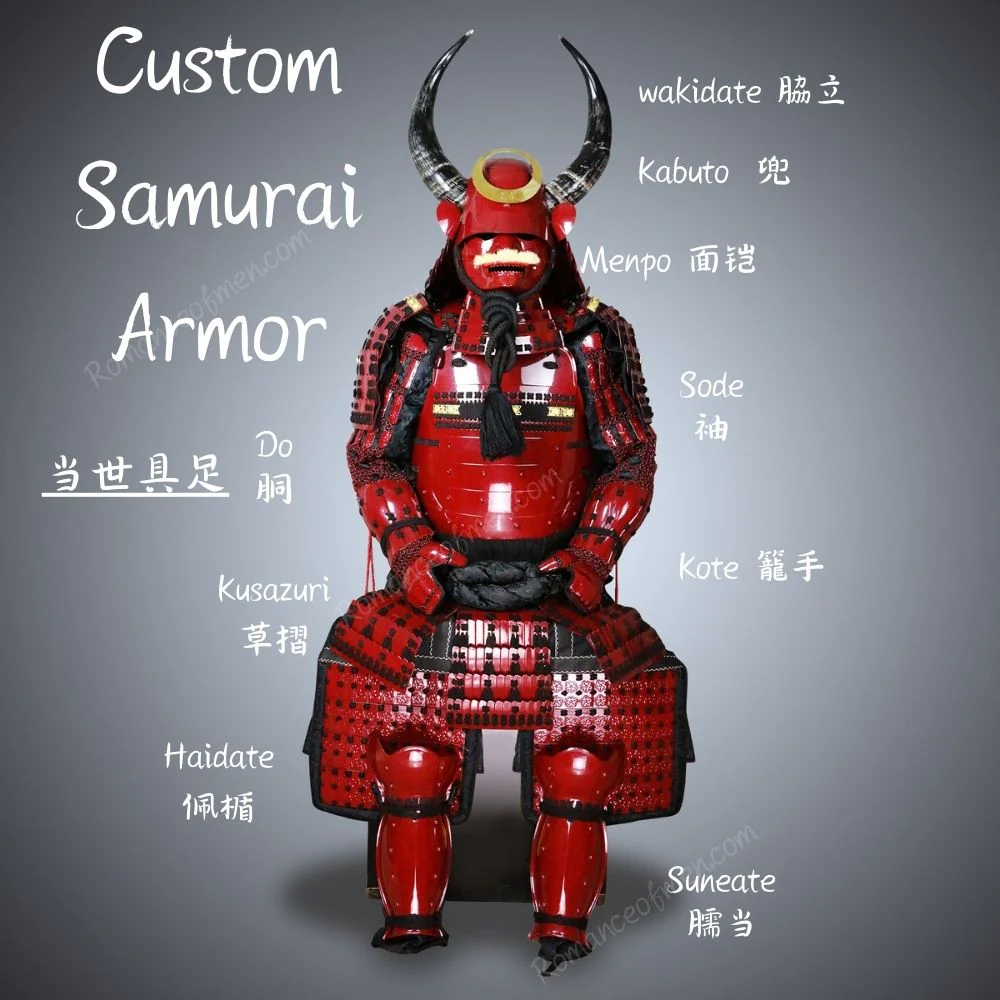A Clash of Cultures: Comparing Samurai and Knight Armor
The samurai of Japan and the knights of medieval Europe were both elite warriors, known for their skill in battle and their distinctive armor. Although they lived in different parts of the world and had unique cultures, their armors served the same basic purpose: to protect them in combat. In this article, we will compare the samurai armor and knight armor, looking at their design, materials, and functionality.

Design and Appearance
Samurai Armor:
- Components: Samurai armor, known as “yoroi,” included several pieces: the kabuto (helmet), menpo (face mask), do (chest armor), kote (armored sleeves), suneate (shin guards), and haidate (thigh guards).
- Style: Samurai armor was often colorful and decorated with intricate designs and clan symbols. The kabuto frequently featured impressive ornaments like horns or crests.
- Flexibility: The design allowed for a good range of movement, which was essential for the samurai’s fighting style that included quick, fluid motions.
Knight Armor:
- Components: Knight armor consisted of a helmet, breastplate, gauntlets (gloves), greaves (leg armor), and sabatons (foot armor), along with chainmail and additional plates for protection.
- Style: European knight armor was more uniform in color, typically polished steel, though it could also be decorated with engravings and sometimes gold accents.
- Bulkiness: Designed to protect against heavy blows, knight armor was heavier and bulkier than samurai armor, but it provided excellent protection against the weapons of the time.
Materials Used
Samurai Armor:
- Materials: Samurai armor was made from a combination of leather, iron, and lacquer. The iron plates were often laced together with silk or leather cords, allowing for flexibility.
- Lacquer: The use of lacquer not only added to the beauty of the armor but also provided protection against rust and the elements.
Knight Armor:
- Materials: Knight armor was primarily made from steel. Earlier versions included chainmail made of interlocking iron rings, and later armors were composed of large steel plates.
- Chainmail: Used as an underlayer, chainmail provided additional protection and flexibility beneath the rigid plates.
Functionality in Battle
Samurai Armor:
- Mobility: The lightweight and flexible design of samurai armor allowed warriors to move quickly and efficiently. This was crucial for the samurai’s combat style, which relied on speed and precision.
- Protection: While offering good protection, samurai armor was designed to balance defense with mobility, which sometimes meant sacrificing some degree of protection compared to knight armor.
Knight Armor:
- Protection: Knight armor was incredibly effective at protecting the wearer from swords, arrows, and other weapons. The full plate design could deflect blows and absorb impacts.
- Weight: The trade-off for this high level of protection was weight and reduced mobility. Knights needed to be strong and fit to move effectively in their armor, and mounting a horse was often necessary for increased mobility.
Cultural Significance
Samurai Armor:
- Symbolism: Samurai armor was more than just protection; it was a symbol of the samurai’s status, clan, and personal honor. The elaborate designs and decorations reflected their rank and identity.
- Rituals: The armor was often involved in various rituals and ceremonies, emphasizing the samurai’s role as both a warrior and a cultural figure.
Knight Armor:
- Chivalry: Knight armor was a symbol of the chivalric code, representing bravery, honor, and service to their lord and the church. It was often used in tournaments and ceremonial events as well as in battle.
- Heraldry: Armor and shields were often decorated with coats of arms, identifying the knight and his lineage. This was an important aspect of medieval European identity.
Evolution and Legacy
Samurai Armor:
- Evolution: Over time, samurai armor evolved to meet the changing needs of warfare, including the introduction of firearms. However, the basic design principles of flexibility and mobility remained.
- Legacy: Today, samurai armor is admired for its craftsmanship and aesthetic beauty. It is preserved in museums and remains a symbol of Japanese cultural heritage.
Knight Armor:
- Evolution: Knight armor also evolved, particularly with advancements in metallurgy. The introduction of gunpowder weapons eventually led to the decline of full plate armor.
- Legacy: Knight armor is a popular subject of historical reenactments and remains a powerful symbol of the medieval European era. It is also displayed in museums and continues to capture the imagination of people around the world.
Conclusion
Both samurai and knight armor were masterpieces of their time, reflecting the values, technologies, and needs of their respective cultures. Samurai armor prioritized mobility and elaborate design, while knight armor focused on maximum protection and martial prowess. Despite their differences, both types of armor share a legacy of bravery, honor, and artistry, continuing to fascinate and inspire people today.